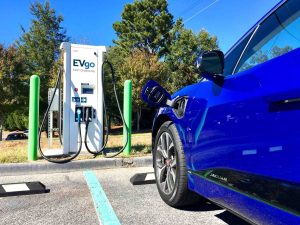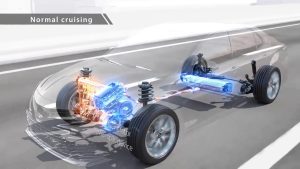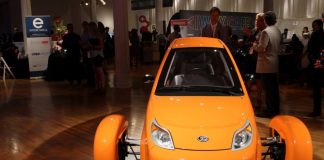That’s what Mr. Spock from Star Trek used to say as a kind of benediction. It applies very much to hybrids, which do just that – and so allow just that.
The why is worth getting into, in view of the push to get people into EVs that do not live long – and so make it hard for you to prosper – because they are entirely dependent upon a battery and it is for exactly that reason you can’t depend on an EV to the extent (or duration) you can depend on a hybrid.
It is often said that EVs have a range problem, but this is not really the problem. It is that if you make full use of an EV’s range then you will have heavily discharged the battery. In order to restore the EV’s range, it will be necessary to recharge the battery and if you do not have the time to wait overnight (or all day) then you will need to “fast” charge the battery using a very high voltage charger.
The catch 22 is that doing this regularly is certain to shorten the useful life of the battery – because it erodes a battery’s ability to retain and accept a charge. You can read the advisories about this in the owner’s manuals of EVs such as the Ford F-150 Lightning I test drove last winter.
So, in order to avoid prematurely aging the battery, you must avoid driving the EV. In order to avoid running down the EV’s battery – and needing to quickly power it back up.
Because it has no back-up.
The battery in a hybrid is never heavily discharged, in part because it is only partially responsible for providing propulsive power; the hybrid’s engine provides its own equal share and it serves as portable generator that keeps the battery charged up as you drive. All of this happens automatically. The system knows when the charge is getting low and on comes the engine/generator to make sure it doesn’t get any lower. And most of the “heavy lifting” – getting the vehicle moving – is done by the engine, with the hybrid side coming online when the load is light, as when cruising/decelerating.
And because the hybrid does not depend entirely on a battery to get (and keep it) moving, it does not need a huge (and extremely heavy) battery, as EVs do. It takes about 800-1,000 pounds of battery to store the energy equivalent of about 8 gallons of gasoline and this is why the typical EV is so obscenely heavy, even though it hasn’t got an engine or a transmission (and its electric motors typically weigh less than most engines). All this weight is a drag on the EV’s range – which means the battery gets discharged more heavily and needs to be “fast”charged more regularly.
Catch meet 22, again.
Hybrid batteries weigh half or less as much as an EV battery, which helps to partially explain why hybrids boast stupendous range. As an example, the ’23 Honda Accord sedan I test drove and reviewed recently has a city driving range of 652 miles (563 on the highway) in part because it weighs only 3,469 lbs. A Tesla 3 – which is a smaller (compact-sized) car – weighs 3,862 lbs. and has a range of just 272 miles.
The owner of the latter would need to fully discharge – and recharge – his Tesla’s battery at least twice to go as far as the Accord hybrid can without stopping, once.
This is not merely a matter of inconvenience – as regards the Tesla. It is a matter of which will endure.
It is also not a matter of speculation in that hybrids have a track record of enduring. The Toyota Prius hybrid has been in mass circulation for some 20 years and many of the early models are still being used as daily drivers. They are commonly in service – as taxis – and that says a lot about living long, because taxis rack up hundreds of thousands of miles in just a few years. If they didn’t endure – for longer than most vehicles – they would not be popular as taxis.
Hybrids also help their owners to prosper – by saving them money otherwise spent on gas. EVs tout this “savings” as well, of course – but it fails to take into account the spending. On the EV (and its battery) which together cost so much that the “savings,” if any, will take years to realize – and by the time that arrives, the battery will likely need to be replaced, entailing yet more spending. 
A hybrid’s battery will eventually need to be replaced as well, of course. But not as soon (most hybrids go 12-15 years before needing a new one) and when they do, the expense is worth the cost because a replacement battery for a hybrid’s doesn’t cost as much (or more than) the car, itself, is worth by then.
A replacement battery for a Prius typically costs about $1,200. A typical replacement EV battery costs $15k-plus. It’s worth spending $1,200 to keep a 12-year-old Prius that’s worth maybe $8k on the road for another five years. It’s not worth spending $15k on a 12-year-old EV that’s worth maybe $15k by the time it needs a new battery.
Just ask Mr. Spock!
. . .
If you like what you’ve found here please consider supporting EPautos.
We depend on you to keep the wheels turning!
Our donate button is here.
If you prefer not to use PayPal, our mailing address is:
EPautos
721 Hummingbird Lane SE
Copper Hill, VA 24079
PS: Get an EPautos magnet or sticker or coaster in return for a $20 or more one-time donation or a $10 or more monthly recurring donation. (Please be sure to tell us you want a magnet or sticker or coaster – and also, provide an address, so we know where to mail the thing!)
If you like items like the Keeeeeeev T shirt pictured below, you can find that and more at the EPautos store!













I’d like to add a little more information on Lithium batteries to what Eric said, since I’ve worked with all kinds of these things.
Lithium batteries, but particularly the most energy dense variant, Lithium Ion Polymer, degrade chemically in three scenarios.
1) Being charged too full.
2) Being discharged too deeply
3) Chemical reaction happening too fast.
The first is easy to avoid, don’t charge cells to full. Even a “100%” charged EV battery isn’t charged to full capacity because it’s only good for 10’s of charges if you do that. Maximum cell voltage is 4.2V, and they typically charge to 4.1V. That 0.1V difference increases battery longevity immensely.
The second is a bit harder to avoid. If the voltage per cell drops below 2.6V, they start to take immediate, irreversible damage. They lose capacity, and change in a way that makes the degradation accelerate on future charges. It’s harder to avoid, because even if you cut off the battery long before it reaches this level, it will self-discharge if not plugged in until it eventually reaches this voltage. Self discharge happens even if nothing is connected or drawing power, the battery very slowly emits heat.
The third happens from charging and discharging too fast. You really don’t want to charge batteries at a rate faster than 1C (meaning their full capacity per hour). For a 100kWh battery, it means 100kW charge rate. A 300kW charger would charge you at 3C, which is a bit harder on the pack, but not as bad as too low or too high voltage.
100kW is 134HP. 350kW is 470HP. When you accelerate one of these fast EV’s (like the Tesla which has 1000HP), you are briefly discharging it at a rate of 7.5C – that is VERY hard on the pack. So, those stabs of exhilarating acceleration are costing you battery longevity.
If you drive these cars, never charging to full, never going below 20% full, and never using much power, they will last forever, I’d guess half a million miles should be no problem for a battery. This, by the way, is exactly how the Prius uses its battery, and that’s why they last forever.
Confused by how government, media, the public, and automakers have just accepted this whole global warming-carbon deadly thing without questions.
I get the government/media complex being in cahoots & the stupid public believing anything the are told, but automakers?? come on. This is a death sentence for your industry.
If no one wants or can afford your product, what do they think will happen? Uncle Sam doesn’t care if they survive or not.
Biden admin roasted for offering to pay Americans to send videos of their electric vehicles: ‘Beyond parody’.
https://www.foxnews.com/politics/biden-admin-roasted-offering-pay-americans-send-videos-electric-vehicles-parody
From link:
“Check it out! The EPA is giving away YOUR money to wealthy EV owners; take a picture of your overpriced government-subsidized EV,” added Jason Isaac, the founder and CEO of the American Energy Institute. “I’m guessing bonus points if it’s at a government-subsidized charging station on a non-racist road in an #EnvironmentalJustice community. #ClimateActionNow.”
What ever became of the flywheels? They were used by Nissan in IMSA (24 hrs of Daytona, Le Mans) for a time when I cared about such things and seemed promising. If stop and start traffic is a problem because of Newton’s first law then spinning up a flywheel with the brakes should help some of that.
Wikipedia says modified London busses get a 20% boost in fuel efficiency with them: https://en.wikipedia.org/wiki/Kinetic_energy_recovery_system#London_buses
Probably expensive and complicated to build, given the mechanical nature. Much easier to use batteries and run cables.
There was already a better solution then EV’s or hybrids….. it got 88.3 mpg imperial, or 73.5 mpg U.S. ….it was so good they had to ban it….
The Volkswagen Golf BlueMotion ice diesel has emissions of 85g CO2 per km..it is even cleaner (less emissions) than a Toyota Prius or an EV….
A bloomberg article states, “A current-model large EV car with a battery produced and charged in an average European Union country emits about 88 grams of CO2 per kilometer,
Ice diesel:
The 2014 Volkswagen Golf BlueMotion diesel, capable of a claimed 88.3 mpg imperial, or 73.5 mpg U.S.
it has a 971 mile range, the perfect car.
it weighs 1125 kg, 2480 lb, the new EV’s are over 4000 lb. it weighs 40% less.
Energy density:
In order to go 200 miles the EV had to carry around a 1000 lb battery (some tesla batteries weigh 1800 lb, the hummer battery is 3000 lb.)
In order to go 200 miles the 2014 Volkswagen Golf BlueMotion diesel had to only carry 9.52 lb of fuel.
The 2014 Volkswagen Golf BlueMotion costs $24,355 U.S., EV’s start at about $45,000
there is a $20,000 incentive to buy the Volkswagen Golf BlueMotion…lol
2014 Volkswagen Golf BlueMotion for sale… $6403.00….buy one…
https://www.motors.co.uk/volkswagen/golf/trim/bluemotion/year/2014/used-cars/
The 2014 Volkswagen Golf BlueMotion diesel…..will last longer then a gas ice engine or gas hybrid engine….it is simpler, lighter, less maintenance, safer, easier to get parts and repair, techs know how to fix them, backyard mechanics can work on them, better fuel economy….there is no battery to replace….
note…a lot of the hybrids will not run after the battery is dead….they won’t run on the gas engine only with a dead battery….a hybrid is too expensive and too complicated…..
the problem with hybrids is the dangerous lithium fire bomb battery….a hybrid just burnt down an entire parkade…lol….
but…hybrids are way better then EV’s…….
But epidemiologists and social workers claim diesels cause asthma, so that’s no good. They did a study of poor people living down by the freeway see, and determined your A7 TDI was harming the children! More importantly, by breezing past the fuel pumps you weren’t paying your “fair share” of the road tax. Out here in Colorado road diesel would usually get cheaper than 85 octane in the summer and be about the same in winter. Those days are long gone thanks to “tax equalization” so the economics don’t make sense.
yes but…….
The Volkswagen Golf BlueMotion ice diesel has emissions of 85g CO2 per km..it is even cleaner (less emissions) than a Toyota Prius or an EV….
cleaner then an EV ….so had to be banned…..
Soooo,,, basically a standard ICE car. Are the batteries necessary… no. Yes the batteries get charged while the engine is running but does it really do any good? Assuming the losses caused by the energy conversion I would bet the car would get the same mileage or better with just the engine. Plus eliminate the motor(s) and the batteries, extra wiring and the heating/cooling system for the batteries one would lighten up the car and would greatly increase the mileage.
IMO the Hybrid is just another compromise adding complication and unnecessary costs. I see no use for them or the full EV. The added cost of the batteries and associated equipment achieve nothing except more troubles not to mention wasting money for virtue seekers.
Wolfgang Hatz, then head of powertrains for Volkswagen, said that hybrid technology is a very expensive way to save a small amount of fuel. He stated that VW only makes hybrids because of political pressure…..
stupid politicians pushing stupid agendas……
the real agenda….stopping the mobility of the slaves…..central control, then elimination of cars….
‘Most of the “heavy lifting” – getting the vehicle moving – is done by the engine, with the hybrid side coming online when the load is light, as when cruising/decelerating.’ — eric
With respect, my understanding is the opposite:
‘The purpose of the HEV is to conserve fuel without sacrificing performance. An HEV achieves this by using electric-motor assist during acceleration and regenerative braking. The ICE turns off at traffic lights and the electric motor propels the car through slow-moving traffic. On full power, both the ICE and electric motor engage for optimal acceleration.
‘HEV batteries operate momentarily, similar to a starter battery, by applying short power bursts for acceleration rather than long, continuous discharges as with an EV.’
https://batteryuniversity.com/article/bu-1002a-hybrid-electric-vehicles-and-the-battery
In effect, the hybrid’s battery and booster motor serve the same purpose as a turbocharger, allowing a small internal combustion engine to momentarily punch above its weight on demand.
But then, ‘batteryuniversity’ runs off the Overton-window rails into rank, climate-shredding heresy:
‘Wolfgang Hatz, then head of powertrains for Volkswagen, said that hybrid technology is a very expensive way to save a small amount of fuel. He stated that VW only makes hybrids because of political pressure. He supports diesel as the most energy-efficient engine.
‘Volkswagen may have a solution — the one-liter car, which burns only one liter of fuel per 100 km. To prove the concept, former VW chairman Dr. Ferdinand Piëch drove the car from Wolfsburg to Hamburg for a shareholders meeting. The average fuel consumption was just 0.89 liters per 100 km (317 mpg).
‘While a typical car has a drag coefficient of 0.30, the one-liter car’s is only 0.16. Carbon fiber and a magnesium frame reduce the weight to 290 kg (640 lb). The one-cylinder diesel engine generates 8.5 hp (6.3 kW), and the 6.5-liter (1.43 gallon) fuel tank has a range of 650 km (400 miles). Its average fuel consumption is 0.99 liter per 100 km (238 mpg).’
Screw the apocryphal 100 mpg carburetor: 238 mpg has been proven in a road test — in a small, light vehicle that wantonly violates dozens of US-fedgov regulations. Whose side are they on?
VW XL1 hybrid diesel for sale
The XL1 was initially unveiled at the Qatar Motor show in 2011. It was fitted with a teeny, mid-mounted 800cc two-cylinder diesel engine producing just 48bhp, which was then linked to a 5.5kWh lithium-ion battery and a 27bhp electric motor, meaning a lofty total output of 75bhp. That power (or lack of it) was sent to the faired-in rear wheels by a seven-speed DSG gearbox.
It was light, though. The body was made from carbon fibre reinforced polymer, the wheels from magnesium and the dampers, steering column and brake callipers from aluminium. ….no rust problems…..
That all meant a 795kg kerb weight, about 1750 lb…….while still meeting all the latest crash-safety requirements. ………no need for modern cars to be over weight…
The body and frame are designed with crush/crumple zones and roll-over protection, and the tandem seating means large side crush zones. Volkswagen claims protection comparable to a GT racing car. The car has anti-lock brakes, airbags with pressure sensors, and stability control…..it only weighs 1750 lb……
why are modern ice cars 3000 to 4000 lb and Ev’s up to 5000 lb or more? they say it was for the so called safety crap….lol
VW says it requires just 8.4 hp to keep the car moving at a steady 60 mph on flat pavement–less than half the power required for the same task in the company’s most economical European production model……why do we need 5000 lb…1000 hp electric cars?
Race-car steering
The unexpectedly fun part of driving the XL1 was the handling.
The unassisted steering–and when’s the last time you drove a car without power steering?–is extremely quick, far closer to that of a track racing car than a street vehicle.
5000 lb EV’s drive like a huge over weight 5 ton truck….lol
and the super slippery body gave the XL1 a drag coefficient of just 0.186, so it remains the most aerodynamic road-going production car ever.
We say production car – only 200 were ever built, so the buyer of this one will join a pretty exclusive hypermiling club. Members of that club will be getting around 313mpg too.
diesel ……so no tune ups like gas ice…
diesels can go 400,000 miles an EV is scrap at 100,000 miles….the very expensive battery is dead…
the VW XL1 hybrid diesel produced emissions of 21g of CO2 per km…far cleaner then an EV….
A current-model large EV car emits about 88 grams of CO2 per kilometer,…EV’s are way dirtier….lol
Volkswagen XL1 Diesel-Hybrid 300 mpg highway
An average EV gets about 20.8 mpg…
the lowest depreciation….. average used price history $103,970, ….. one sold for $134,000 used….original MSRP of around $128,113….
it was only made in 2015, that is 7 years depreciation…..a $128,000 ice vehicle in 7 years is worth about $42,000…..
after 100,000 miles, about ten years, a $50,000 EV is worth zero because the very expensive…$22,000 to $29,000 battery is dead….
Produced solely for the 2015 model year, the XL1 saw only 200 examples built.
sounds like the best car ever built……with today’s fuel prices….
https://www.topgear.com/car-news/hybrid/buy-volkswagen-xl1-auction-become-hypermiler
VW has the best engineers for light fuel efficient cars….
quote…..the one-liter car, which burns only one liter of fuel per 100 km. To prove the concept, former VW chairman Dr. Ferdinand Piëch drove the car from Wolfsburg to Hamburg for a shareholders meeting. The average fuel consumption was just 0.89 liters per 100 km (317 mpg).
….that is a better car in many ways then the XL1….because no battery or electric motor…non hybrid….
Hi Jim,
I’ve driven probably 100 (or more) hybrids of various makes/models over the years and I can tell you that, unless you accelerate glacially – as if there were a Faberge egg under the pedal – the gas engine will come on and do most of the work of getting the car moving. The main (gas) savings is light-load when the engine cuts off or isn’t used much. Most non-plug-in hybrids are primarily moved by the engine. The battery/motor provides an assist – and keeps the accessories running when the engine is off.
It’s all about making the most of the system. It is possible to get phenomenal mileage (50-plus) out of a hybrid, but to get it, you generallymust drive it gently.
The VW high mileage one cylinder diesel car is very light…..290 kg (640 lb)
It is lighter then Gordon Murray’s Light Car Company Rocket….which weighs 834 lb….
it has a Yamaha four-cylinder bike motor, mounted in the rear. Early models used a 143-hp 1000cc motor, Evo reports; later, it grew to 1070cc and 171 hp. And it revs to 11,000 RPM.
no more than 55 were built during its 1991-1998 run. That makes it rarer than both the McLaren F1 and the new T.50. It’s also noticeably cheaper than either too.
In its day, the Rocket retailed at roughly $50,250; that’s the modern equivalent of $95,600. And it hasn’t gotten any cheaper over the years. In 2014, one was listed at $99.5k, Bring a Trailer.
https://www.motorbiscuit.com/before-the-mclaren-f1-gordon-murray-made-a-rocket/
The VW high mileage one cylinder diesel car is very light…..290 kg (640 lb)…. The one-cylinder diesel engine generates 8.5 hp (6.3 kW), and the 6.5-liter (1.43 gallon) fuel tank has a range of 650 km (400 miles). Its average fuel consumption is 0.99 liter per 100 km (238 mpg).’
You could sort of copy it……
Get a Super 7 clone…take some weight out….down to under 1000 lb….then do an engine swap for a 1 cylinder… 8 Hp Yanmar diesel….they are simple and bulletproof…run forever….
probably get far above 100 mpg
could be built for under $20,000 and is road legal…..
A high mpg super 7…Caterham 170 ….58.3mpg
https://www.goodwood.com/grr/car-reviews/caterham/170s/